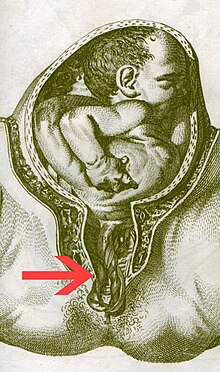Umbilical cord prolapse
| Classification according to ICD-10 | |
|---|---|
| O69.0 | Labor and delivery complications from umbilical cord prolapse |
| ICD-10 online (WHO version 2019) | |
The umbilical cord prolapse is an obstetric emergency in which the umbilical cord slips in front of the previous part of the child in the event of a premature rupture of the bladder or during the birth after the rupture of the bladder , which can be pinched off. This complication, which is dangerous for the child, can lead to a lack of oxygen ( hypoxia ) with possible disability or even death of the fetus. If the umbilical cord comes to lie in front of the preceding part of the child while the amniotic sac is still intact , one speaks of the presence of the umbilical cord .
Epidemiology and etiology
The frequency of the umbilical cord incident is around 0.3% of all births in Germany. The cause is considered to be poor sealing of the birth canal by the child. Predisposing are hiring , positional and posture abnormalities , premature births , hypotrophic children, a hydramnios and a deep seat of the placenta . In twin pregnancies in monoamniotic ("identical") twins, the second twin is always threatened by an umbilical cord prolapse, in diamniotic twins only if the rupture of the bladder occurs before it has settled in the maternal pelvis.
A relative disproportion, which arises when the child's head is still high above the pelvic entrance when the bladder ruptures, also favors an umbilical cord prolapse.
An amniotomy in a child who is not yet employed can lead to an iatrogenic umbilical cord prolapse. Umbilical cord incidents are most frequently observed in the case of transverse , oblique or foot position and multiple births .
Symptoms and diagnostics
The first indications of the presence or prolapse of the umbilical cord are newly occurring variable decelerations and bradycardias on cardiotocography (CTG). The suspected diagnosis is then confirmed with vaginal palpation : the pulsating umbilical cord can be felt in front of the child's part. If you continue to doubt the diagnosis is through the speculum at sufficiently open cervix or by a Amnioskopie verified.
therapy
Presence of the umbilical cord
When the umbilical cord is present , it can often be repositioned by elevating the pelvis or lying on the side of the pregnant woman . In these cases, physiological vaginal birth is possible: the birth is initiated with continuous monitoring of the child by cardiotocography , while an operating theater team is available to perform a caesarean section if there are complications .
If the fetal bradycardia proves to be very pronounced, intrauterine resuscitation is carried out by administering fenoterol (partusists), a beta sympathomimetic .
Umbilical cord prolapse
In the event of an umbilical cord incident, an immediate caesarean section is performed as an emergency in order to avoid hypoxia in the child . In order to relieve the umbilical cord until the start of the operation, the maternal pelvis is elevated and the preceding part of the child including the umbilical cord is pushed back from the vaginal area into the uterine cavity with one hand . If the fetal bradycardia is very pronounced, an intrauterine resuscitation must be attempted with fenoterol . Possibly. tocolytics must also be infused slowly.
If premature rupture of the bladder is diagnosed, the condition of the fetus must be precisely determined by means of cardiotocography and sonography before the planned cesarean section . If the fetus is dead or if the fetal bradycardia has persisted for more than 20 minutes, vaginal delivery should be initiated.
Precautions
If the child's head does not yet relate to the pelvis after a rupture of the bladder , the pregnant woman should be brought to hospital by ambulance in a lying position on her left side to avoid vena cava compression syndrome in order to prevent an umbilical cord prolapse.
literature
- M. Stauber, T. Weyerstahl: Dual series of gynecology and obstetrics. 3. Edition. Thieme Verlag, Stuttgart 2007, ISBN 978-3-13-125343-9 .
- Heinrich Schmidt-Matthiesen, Diethelm Wallwiener: Gynecology and obstetrics. 10th edition. Schattauer, Stuttgart 2004, ISBN 3-7945-2260-5 .
- W. Pschyrembel , JW Dudenhausen: Practical obstetrics. 17th edition. Walter de Gruyter, Berlin 1991, ISBN 3-11-012881-0 , p. 421 ff.
Individual evidence
- ↑ T. Schneider, B. Wolcke, R. Böhmer, T. Merz (eds.): Pocket Atlas Emergency & Rescue Medicine : Compendium for the emergency doctor. Springer Verlag, 2013, ISBN 9783662130810 , p. 294.
- ↑ Andreas Secchi, Thomas Ziegenfuß: Checklist emergency medicine. Georg Thieme Verlag, 2009, ISBN 9783131510549 , p. 366.
